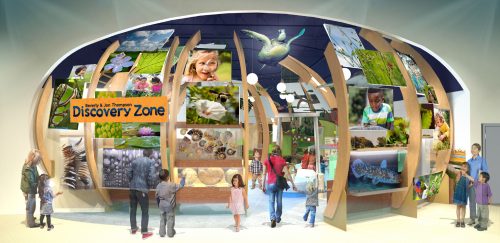
GAINESVILLE, Fla. — The Florida Museum of Natural History will open its new “Beverly and Jon Thompson Discovery Zone” July 17, an exciting interactive, free permanent exhibit showcasing a diverse range of educational science-based activities for children to age 8 and their caregivers.
The exhibit features developmentally appropriate components focused on teaching about the world around us: plants, animals and people, both past and present. An array of objects and resources invite exploration and discovery, from a touchable replica of a T. rex skull and a meteorite to insects to closely examine.
“Our community, indeed the region, has very little other informal education spaces like this for young children,” said Darcie MacMahon, Florida Museum exhibits and public programs director. “We hope to inspire, early in children’s lives, a passion for life on Earth.”
Activities include multiple touchscreen interactives, touch and audio stations to identify animals living nearby and an area with replica skulls and bones. The exhibit also includes an area designed for toddlers, as well as a small fishing boat where children can go on a pretend Gulf of Mexico expedition and identify the species they catch.
The heart of the new exhibit is a sculpted, larger-than-life passion flower vine featuring eggs, larvae, pupae and an adult zebra longwing, Florida’s state butterfly. Other sculptures hanging above the exhibit include a giant turtle, large-scale nautiloid, sawfish and a turkey in flight.
The “Discovery Zone” is designed to inspire children and engage them in science inquiry through exploring materials, asking questions, investigating and creating new ideas about how the world works. The exhibit objects and resources allow the museum’s youngest visitors to use a variety of tools and make careful observations; compare, sort and classify; and work collaboratively with others.
“The museum spent a lot of time looking at best practices in early childhood education and also early learning standards so we would be appropriate in the kinds of activities and information incorporated into the exhibit,” said Betty Dunckel, program director for the Florida Museum Center for Science Learning. “We also view the exhibit as a first stop for the younger audiences as an introduction to more of the permanent exhibit halls.”
To provide maximum convenience, the exhibit also includes a family restroom with adult- and child-sized fixtures. The “Discovery Zone” has limited capacity for visitors and scheduled entry times may be needed to allow all families an opportunity to enjoy the exhibit.
This 2,000-square-foot exhibition was developed by the Florida Museum with design and construction partners including Lee H. Skolnick Architecture + Design Partnership, Brentwood Construction, Brilliant Creative Fabrication and Walker Architects Inc. Total design and construction costs are about $2.5 million, with more than half provided by private donors.
The “Discovery Zone” is sponsored in part by the Florida Division of Cultural Affairs, Florida Division of Historical Resources, Alachua County Board of County Commissioners through the Tourist Development Tax, and generous contributions from individuals and private foundations.
For more information about the “Beverly and Jon Thompson Discovery Zone” visit www.floridamuseum.ufl.edu/exhibits/discovery-zone.
For more information on the Florida Museum, visit www.floridamuseum.ufl.edu or call 352-846-2000.
-30-